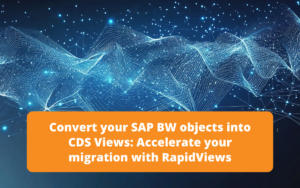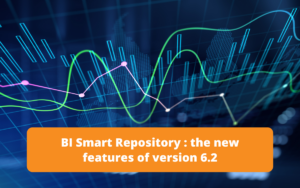What is the Cloud version of SAP S/4HANA?
S/4HANA is SAP’s ERP (Enterprise Resource Planning) based on In-Memory technology. This technology enables data to be loaded into the system’s RAM (random access memory) in order to respond instantly to customers’ analytical needs, and allows users to consult data from different S/4HANA domains more quickly and in real time to speed up processes.
In February 2017, SAP launched the Saas (Software as a Service) version of S/4HANA. It offers companies a fast and simple implementation of an ERP system without allocating resources to hardware, databases or the IT team. SAP S/4HANA Cloud evolves continuously, integrating SAP’s functional and technical updates and innovations on a quarterly basis.
This ‘next-generation intelligent ERP’ runs on the SAP HANA in-memory database, which, combined with the use of artificial intelligence, makes it possible to analyse a huge amount of data. What’s more, the various integrated technologies (AI, ML, business intelligence) considerably broaden the options available compared with an on-premise version.
The main functions covered by SAP S/4 HANA Cloud are: finance, sales, supply chain management, supply chain, production, human resources management, services and fixed asset management.
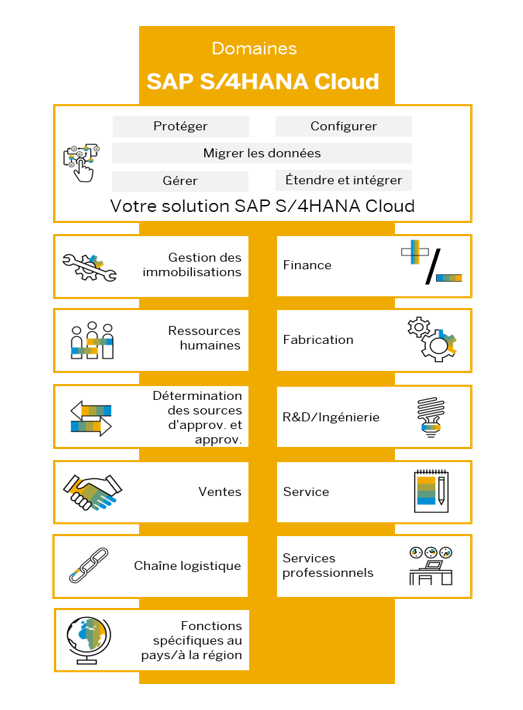
A complete, integrated cloud solution
The S/4HANA cloud solution automatically connects to an integrated suite of SAP applications to meet specific business needs, such as Ariba for purchasing, SAP Hybris for CRM, SAP SuccessFactors for human resources management, SAP Analytics Cloud for operational reporting, predictive analysis reporting and dashboard creation.
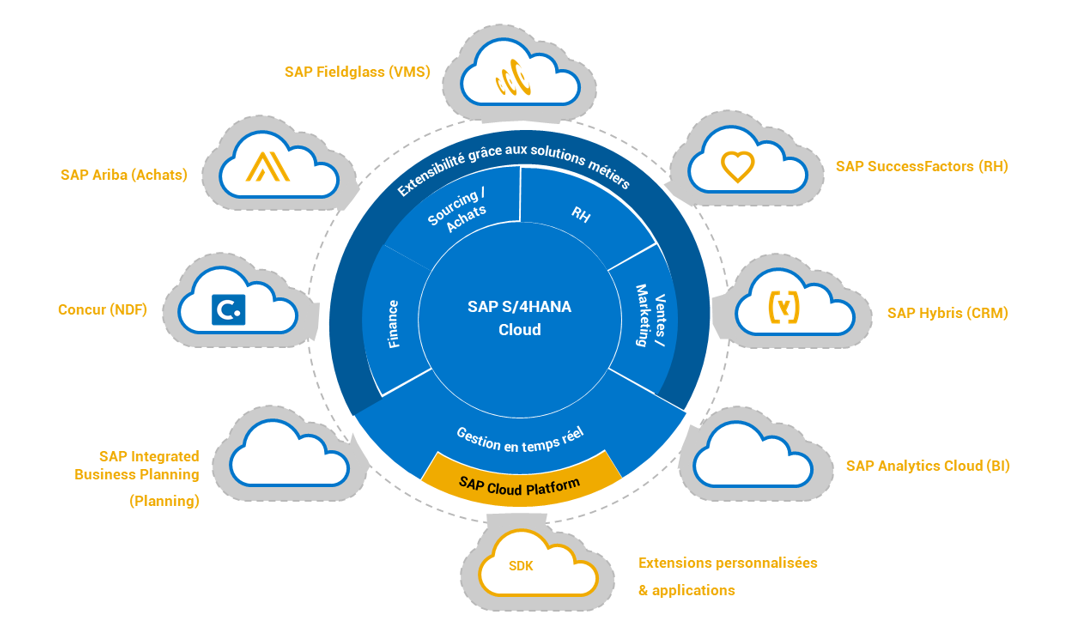
Subscribe to the Rapid Views Newsletter !
Stay up to date with our latest blog posts, upcoming webinars and news!
SAP S/4HANA Cloud Vs SAP S/4HANA On-Premise
Both versions of S/4HANA ERP are based on the SAP Fiori design, which simplifies and customises the user experience. In practical terms, this means that S/4HANA Cloud and S/4HANA On-Premise share similar functionalities, but their implementation and handling are different.
The On-Premise version offers greater flexibility than the Cloud version, particularly in terms of managing and adapting business processes to customers’ needs. On the other hand, the Cloud version offers greater standardisation thanks to pre-configured processes, and faster deployment and scalability.
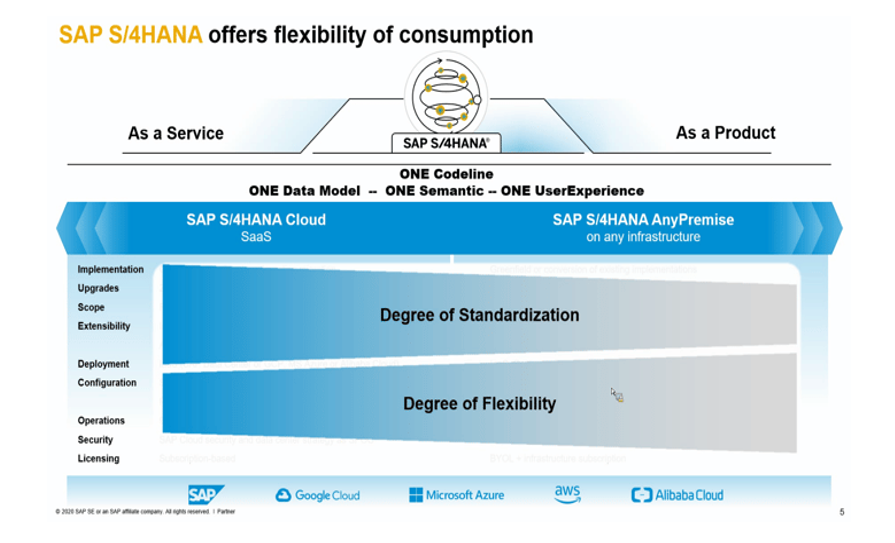
The main differences of interest to customers are as follows:
| S/4HANA Cloud | S/4HANA On-Premise | |
| Licence model | Subscription licence | Traditional licence |
| Infrastructure and maintenance | The system’s infrastructure and maintenance are managed by SAP | Deployment and maintenance are managed by the customer. |
| Implementation | Faster implementation, thanks to the use of a ready-to-use platform that has already been provisioned, implemented and tested by the cloud provider | Implementation requires more time, cost, effort and adequate staff to set up the new environment. |
| Customised processes | La version cloud bénéficie de la pré-configuration de SAP, et donc moins de flexibilité pour personnaliser les processus métier. | The on-premise version gives customers greater flexibility and control in terms of customisation. |
| Upgrades and support packages | The cloud version benefits from SAP’s pre-configuration, and therefore less flexibility to customise business processes.
| Annual upgrade. The customer decides the frequency and timing of software upgrades or implementation of the latest support packages.
|
| Scalability | Quarterly upgrade by SAP. The private edition allows the customer to choose the timing and functionality of the upgrade. | Planning, testing, monitoring, upgrading and modifications within the system are the sole responsibility of the customer.
|
The different editions of SAP S/4HANA Cloud
The versions of SAP S/4HANA Cloud have gone through many names since 2017 (S/4HANA Cloud Essentials Edition, S/4HANA Cloud Multi-Tenant Edition, S/4HANA Cloud Extended Edition, S/4HANA Cloud Single Tenant Edition). SAP now offers 2 options: the public cloud edition and the private cloud edition.
1. SAP S/4HANA Cloud, public edition
This edition is based on a public cloud approach shared by other customers and is managed on a subscription basis. SAP S/4HANA Cloud is fully hosted, operated and maintained by SAP. ERP updates are also managed by SAP, which delivers a version every quarter.
The public cloud version of SAP S/4HANA is the most limited. The implementation of this version leads to the activation of SAP Best Practice business processes and therefore does not allow customers to rethink their business processes. Deployment is in Greenfield mode.
The main advantages of the public edition of SAP S/4HANA Cloud lie in the very short implementation times (30 days maximum), as well as significantly lower implementation costs.
2. SAP S/4HANA Cloud, édition privée
This version is being launched by SAP in 2021, and offers a new level of flexibility compared with the public cloud version. It combines the benefits of the cloud with the advantages of an on-premise installation. It allows customers to customise their ERP to suit their needs and have control over their system, while being managed by cloud hyperscalers (mainly Amazon Web Services, Microsoft Azure and Google). This makes this version three times more expensive than the public version.
It can be deployed in Greenfield or Brownfield mode. It can also be implemented in “Hybrid” mode. This model combines the advantages of both on-premise and cloud versions.
New technologies in SAP S/4HANA Cloud
The cloud version is continually innovating with the integration of new features such as artificial intelligence (AI), machine learning (ML), robotic process automation (RPA) and analytics to help your business run more smoothly:
SAP Digital Assistant
SAP CoPilot, SAP’s virtual assistant, is one of the features of SAP S/4HANA Cloud that uses artificial intelligence to help users accomplish certain tasks (creating live discussions, adding notes, creating or adding existing objects, etc.). It offers a unique experience to each user through voice and text commands, by exploiting data relating to the user and their work to propose relevant information.
SAP Machine Learning
Machine learning integrated into SAP S/4HANA Cloud enables users to automate recurring tasks. This avoids errors caused by manual intervention.
SAP Predictive analytics
Thanks to its predictive analysis functionality, SAP S/4HANA Cloud enables users to make relevant decisions quickly. The statistical analyses and data extractions used by this functionality enable predictive models to be created in order to discover information and relationships hidden within the data. This enables the user to make predictions about future events. In effect, the analysis tool can predict the results of certain actions by taking into account all the data it possesses.
Conclusion
SAP S/4 HANA Cloud offers companies looking for an ERP solution the opportunity to implement a harmonised and efficient solution with a faster return on investment. The cloud solution offers a number of benefits, including reduced cost of ownership, a pre-configured platform for faster implementation, improved decision-making and accelerated innovation.
Finally, with this cloud version, the acquisition and use of SAP ERP becomes more accessible to SMEs.

